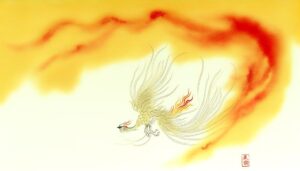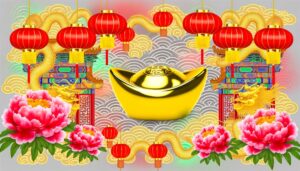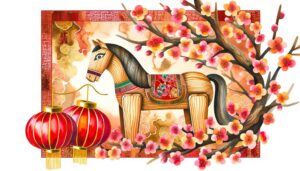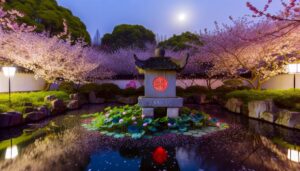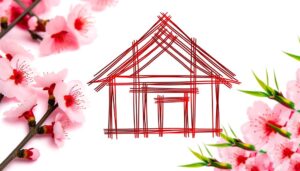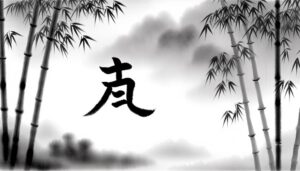How to Draw the Chinese Symbol for the Year of the Rabbit
The Chinese symbol for the Year of the Rabbit, '兔' (Tù), holds significant historical and cultural importance. The Rabbit symbolizes qualities such as grace, calmness, and sensitivity, embodying ideals of gentleness, elegance, and vigilance.
In the Chinese zodiac, it represents peace, prosperity, and longevity, aligning with societal values of diplomacy and nurturing. The character '兔' has auspicious and mystical connotations, deeply rooted in Chinese mythology and Feng Shui principles, enhancing harmony and prosperity.
Understanding its rich historical background and cultural symbolism opens pathways to deeper insights and appreciation of its enduring significance.
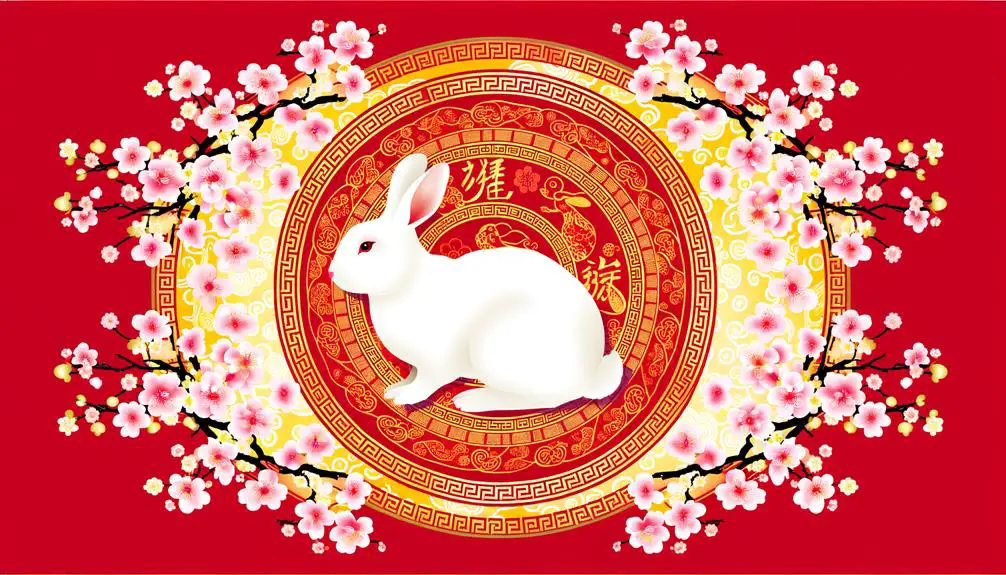
Key Takeaways
- The Chinese character for the Year of the Rabbit is '兔' (Tù).
- '兔' (Tù) symbolizes gentleness, elegance, and vigilance.
- The Rabbit represents peace, longevity, and prosperity in the Chinese zodiac.
- The Rabbit is the fourth animal in the 12-year Chinese Zodiac cycle.
- The Rabbit's symbolism highlights qualities like tranquility, sensitivity, and good fortune.
Historical Background
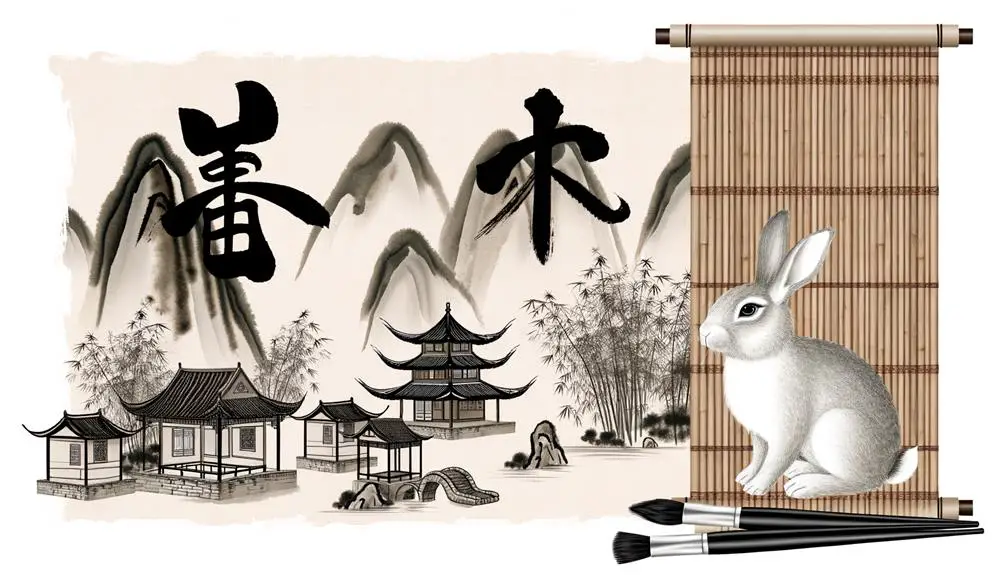
The historical background of the Chinese symbol for the Year of the Rabbit is deeply rooted in the ancient Chinese zodiac system, which dates back to the Han Dynasty (206 BCE – 220 CE).
This zodiac system is a cyclical calendar that assigns twelve animals to each year in a repeating 12-year cycle. The Rabbit, known as one of the twelve earthly branches, is the fourth animal in this sequence. Ancient Chinese astronomers and scholars meticulously mapped the calendar to align with lunar cycles and agricultural seasons.
The integration of the Rabbit into this system reflects the era's profound connection between celestial phenomena and terrestrial life. This historical context underscores the intricate tapestry of cultural and temporal interdependencies characteristic of traditional Chinese society.
Symbolism and Meaning
Representing grace, calmness, and sensitivity, the Rabbit holds significant cultural symbolism in Chinese tradition, reflecting both personal and societal virtues valued throughout history.
In the Chinese Zodiac, the Rabbit is the fourth animal, embodying qualities of gentleness, elegance, and vigilance. Historically, the Rabbit is seen as a harbinger of peace and prosperity, often associated with the moon and feminine energy. Its presence in folklore and art underscores themes of longevity and well-being.
The symbolism extends to societal values, highlighting the importance of diplomacy, subtlety, and nurturing in human interactions. This cultural emblem serves as a reminder of the virtues that sustain harmony and balance within both individuals and communities.
The Character '兔' (Tù)
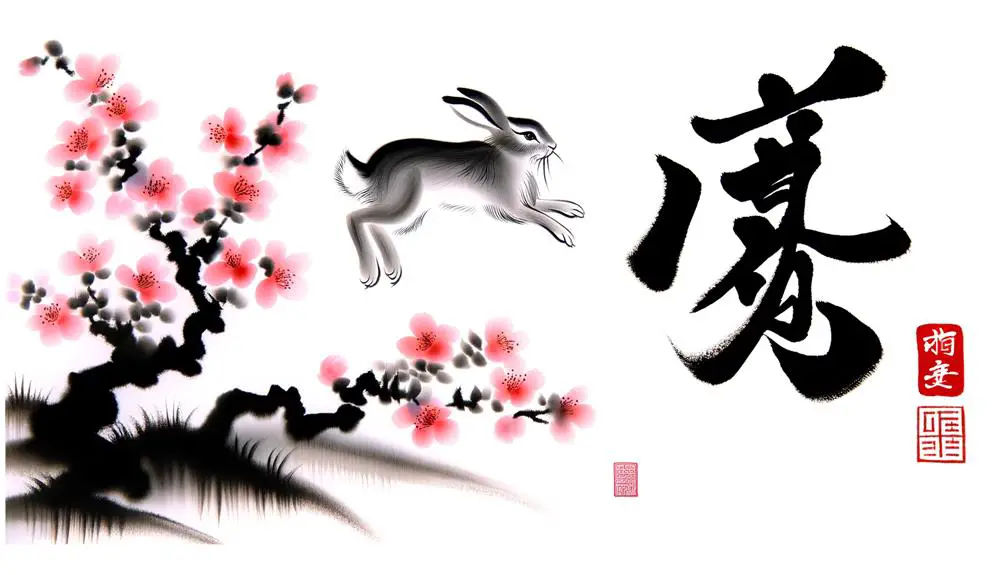
The character '兔' (Tù), representing the rabbit in the Chinese zodiac, carries profound symbolic meanings deeply rooted in Chinese culture. Historically, it has been associated with qualities such as gentleness, elegance, and a sense of vigilance, reflecting the traits attributed to the animal itself.
Culturally, the rabbit serves as a harbinger of peace and longevity, enriching its significance in various traditional celebrations and folklore.
Symbolic Meanings Explored
Exploring the symbolic meanings of the Chinese character '兔' (Tù) reveals its deep-rooted cultural significance and historical context in Chinese society.
The character '兔' is associated with the Year of the Rabbit in the Chinese zodiac, representing qualities such as gentleness, elegance, and vigilance.
Historically, the rabbit has been a symbol of longevity and prosperity, often depicted alongside the moon, enhancing its mystical and auspicious connotations.
In Chinese folklore, the Jade Rabbit accompanies the Moon Goddess Chang'e, serving as a celestial emblem of compassion and sacrifice.
This rich tapestry of meanings underscores the rabbit's esteemed position within Chinese mythology and highlights its enduring relevance in contemporary cultural practices.
Cultural Significance Analyzed
Building on the rabbit's rich symbolic tapestry, the character '兔' (Tù) embodies profound cultural significance, reflecting key aspects of Chinese values and societal norms. Historically, the rabbit has been seen as a symbol of longevity and auspiciousness, deeply rooted in ancient Chinese folklore and mythology.
This character also signifies attributes such as gentleness and elegance, which are highly regarded in Chinese culture. Moreover, '兔' (Tù) is associated with the lunar calendar, playing a pivotal role in astrology and traditional celebrations.
Key cultural significances include:
- Longevity and Auspiciousness: Symbolizes good fortune and long life.
- Gentleness and Elegance: Embodies qualities admired and encouraged in society.
- Astrological Importance: Integral to the Chinese zodiac, influencing personality traits and destiny.
Rabbit in Chinese Zodiac
In what ways does the Rabbit, a symbol of tranquility and elegance, play a pivotal role in Chinese Zodiac traditions?
Historically, the Rabbit is the fourth animal in the 12-year Chinese Zodiac cycle, embodying qualities such as gentleness, sensitivity, and artistic talent.
Culturally, the Rabbit signifies peace, prosperity, and longevity, often associated with positive connotations in literature and folklore.
This emblematic animal is revered for its ability to navigate life with grace and calmness, reflecting deep-rooted values in Chinese society.
Its presence in the Zodiac also influences personality traits and life predictions for individuals born under its sign, suggesting a life of harmony and refined aesthetics.
This intricate symbolism underscores the Rabbit's enduring legacy in Chinese cultural heritage.
Lunar New Year Traditions
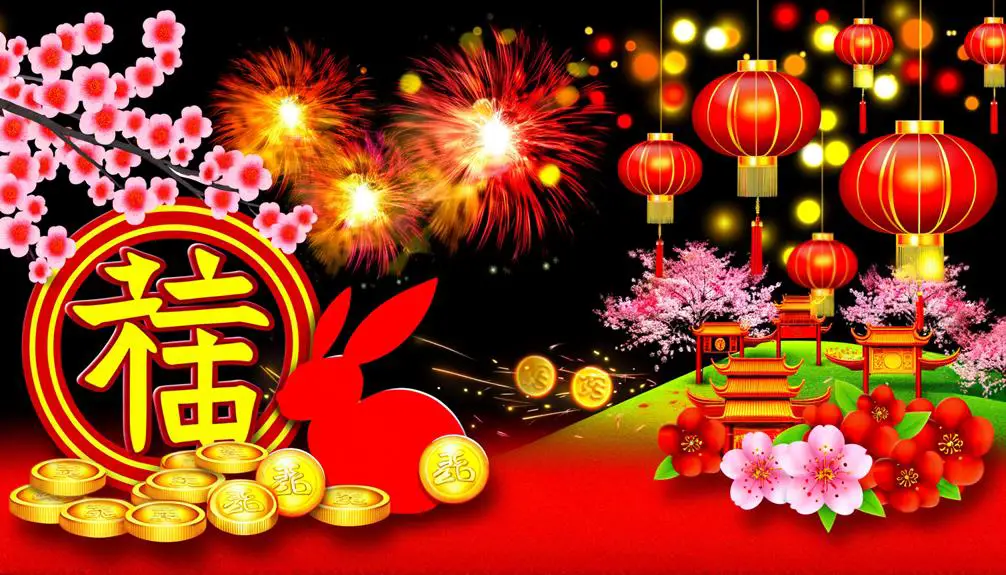
Lunar New Year traditions are deeply rooted in historical customs and cultural symbolism, reflecting the rich heritage of Chinese society.
Central to these celebrations are festive foods that not only signify prosperity and good fortune but also serve as a bridge connecting generations through shared culinary practices.
Additionally, the various cultural celebrations, including lion dances and lantern festivals, underscore the communal spirit and enduring significance of this annual event.
Traditional Festive Foods
Central to the Lunar New Year celebrations are traditional festive foods. Dumplings, fish, and rice cakes carry profound cultural symbolism and historical significance, reflecting the values and hopes for prosperity and unity in the coming year. These foods are meticulously prepared and served to honor age-old customs, each imbued with meanings that transcend culinary enjoyment.
- Dumplings (Jiaozi): Resembling ancient Chinese silver ingots, they symbolize wealth and prosperity.
- Fish (Yu): The word for fish sounds like 'abundance' in Chinese, making it a staple for wishes of surplus.
- Rice Cakes (Nian Gao): Their name means 'year higher,' symbolizing progress and growth.
These dishes encapsulate the essence of Lunar New Year, uniting families in shared aspirations.
Cultural Celebrations Explained
Celebrating the Lunar New Year, communities across the world engage in a rich tapestry of traditions that not only mark the passage of time but also reinforce cultural identity and communal bonds.
Historically, the celebration originates from agrarian societies in ancient China, where it symbolized the end of winter and the beginning of a new agricultural cycle.
Cultural symbolism is deeply embedded in activities such as dragon and lion dances, which are believed to ward off evil spirits and bring good fortune. The giving of red envelopes, adorned with auspicious symbols, signifies the transfer of luck and prosperity.
These practices, steeped in historical significance, offer a profound understanding of the values and beliefs that sustain and enrich Chinese culture through generations.
Rabbit in Chinese Art
Portraying the rabbit in Chinese art invokes a deep cultural symbolism that reflects historical significance and contextual nuances within Chinese traditions. The rabbit, often depicted with elegance and grace, embodies themes of longevity, fertility, and tranquility. This symbolism permeates various forms of Chinese art, from ancient pottery to intricate paintings.
Below are three key aspects of the rabbit's representation in Chinese art:
- Historical Artifacts: Ancient jade sculptures and bronze artifacts frequently feature rabbit motifs, underscoring their revered status.
- Literary References: Classical literature and poetry often use the rabbit as a metaphor for purity and gentleness.
- Visual Arts: Traditional Chinese paintings and silk embroideries illustrate rabbits amidst natural landscapes, symbolizing harmony and peace.
This rich artistic tradition underscores the rabbit's profound cultural resonance.
Modern Celebrations
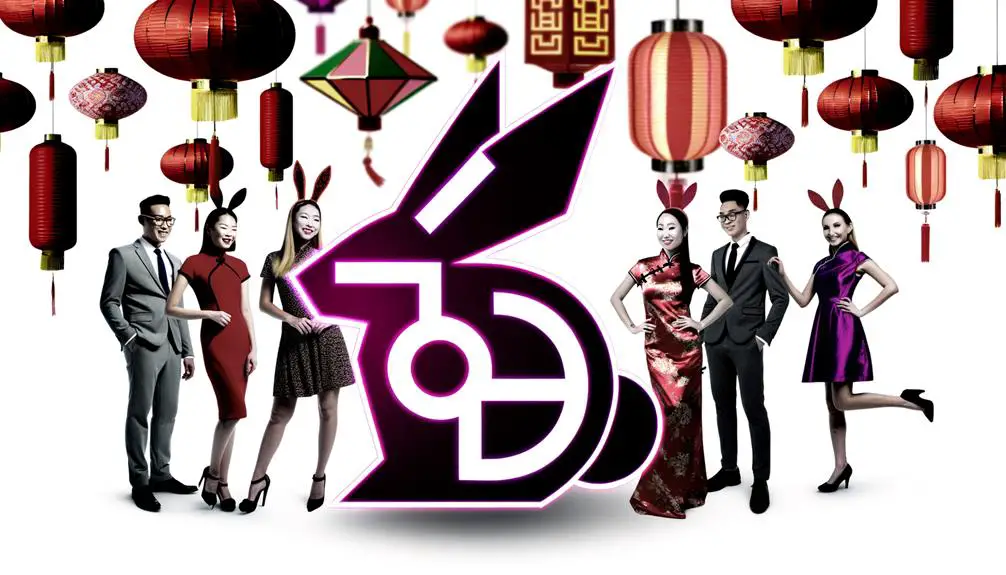
Modern celebrations of the Year of the Rabbit blend historical traditions with contemporary festivities, showcasing the enduring cultural symbolism of the rabbit.
Lunar New Year traditions, such as family reunions and the giving of red envelopes, are enriched by popular rabbit-themed events that capture the public's imagination.
These celebrations underscore the rabbit's significance in Chinese culture, reflecting its attributes of tranquility and good fortune in modern contexts.
Lunar New Year Traditions
The Lunar New Year, rich in historical significance and cultural symbolism, is marked by a blend of age-old traditions and contemporary practices that reflect the dynamism of Chinese society. This vibrant celebration harmonizes rituals of the past with the modernity of today's world, ensuring cultural continuity while embracing change.
Key traditions include:
- Reunion Dinners: Families gather for a lavish meal on New Year's Eve, symbolizing unity and prosperity.
- Red Envelopes (Hongbao): Elders gift red envelopes filled with money to younger generations, signifying good luck and warding off evil spirits.
- Fireworks and Lion Dances: These performances are believed to scare away evil spirits and bring good fortune, illustrating the seamless blend of historical customs with contemporary festivities.
Popular Rabbit-Themed Events
Celebrating the Year of the Rabbit, modern festivities across various Chinese communities creatively integrate rabbit-themed events that underscore the animal's cultural symbolism of longevity, peace, and prosperity.
Parades, often featuring elaborate rabbit costumes and floats, attract large crowds, emphasizing the rabbit's association with gentleness and harmony.
Additionally, art exhibitions and workshops dedicated to rabbit-inspired crafts reflect historical reverence for the creature in traditional Chinese art.
In culinary circles, special dishes like rabbit-shaped pastries are crafted, blending modern gastronomy with age-old symbolism.
These events not only honor the rabbit's attributes but also foster communal bonds and continuity of cultural heritage, weaving ancient beliefs into contemporary celebrations.
Such festivities serve as a vibrant proof to the enduring legacy of the rabbit in Chinese culture.
Feng Shui and Rabbits
In the context of Feng Shui, the Rabbit symbolizes tranquility, elegance, and auspiciousness, making it a significant figure in the domain of Chinese metaphysics and interior design. Throughout history, the Rabbit has been revered for its gentle and harmonious nature, aligning perfectly with Feng Shui principles that seek to balance energies within a space.
The cultural symbolism of the Rabbit extends to various aspects of Feng Shui practice:
- Enhancing Harmony: Placing Rabbit imagery in the home promotes peace and gentle energy.
- Attracting Prosperity: Rabbits are believed to attract good fortune and financial success.
- Boosting Relationships: Displaying Rabbit figures can strengthen personal and professional relationships.
These elements underscore the Rabbit's enduring historical and cultural significance in Feng Shui.
Famous Rabbit Legends
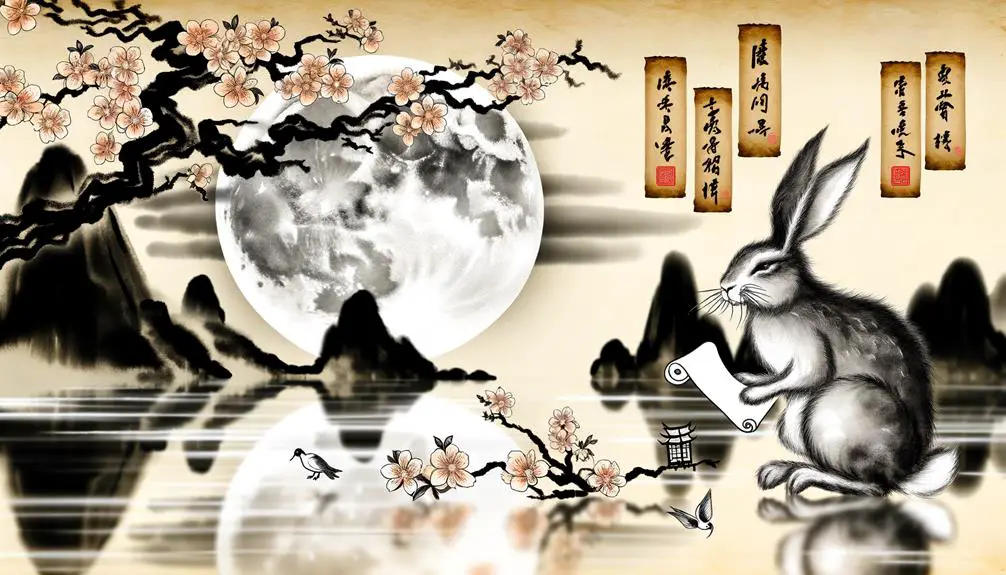
Delving into famous rabbit legends reveals a rich tapestry of cultural symbolism and historical significance across various civilizations.
In Chinese mythology, the Jade Rabbit, or Moon Rabbit, is a celestial creature that lives on the Moon, pounding the elixir of immortality. This legend underscores themes of longevity and purity.
In Native American lore, the trickster rabbit Nanabozho is a central figure, embodying the cunning and transformative qualities of nature.
Additionally, the European fable of Br'er Rabbit, originating from African folklore, portrays the rabbit as a clever survivor, navigating a world of larger, more imposing creatures.
These legends collectively highlight the rabbit's symbolic roles in wisdom, survival, and spiritual aspiration, reflecting its esteemed place in global mythological narratives.
Global Influence
The global influence of the rabbit symbol spans diverse cultures, manifesting in unique traditions, folklore, and artistic expressions that underscore its universal relevance.
Historically, the rabbit has been a symbol of fertility and renewal, deeply embedded in various mythologies. Culturally, it finds representation in numerous global festivities, often associated with themes of luck and prosperity.
Key examples of its global influence include:
- Easter Bunny: In Western cultures, the rabbit signifies rebirth and is central to Easter celebrations.
- Japanese Folklore: The Moon Rabbit myth in Japan symbolizes perseverance and sacrifice.
- African Traditions: In African folklore, the rabbit is often depicted as a clever trickster, reflecting human ingenuity.
These instances highlight the rabbit's enduring symbolic power across different societies.
Conclusion
The Chinese symbol for the Year of the Rabbit, encapsulated in the character '兔' (Tù), intertwines historical significance, cultural symbolism, and modern relevance.
As a beacon in the Chinese zodiac, it heralds a time of tranquility and introspection.
The rabbit's gentle spirit permeates Lunar New Year traditions, contemporary celebrations, and even Feng Shui practices.
This enduring symbol, enriched by legends and global influence, continues to shape societal narratives, reflecting a tapestry of heritage and collective consciousness.

